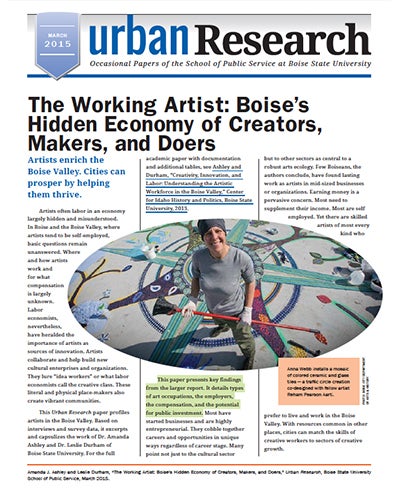Report Looks at Working Artists and the Economy

A new report published by Boise State University examines the role of art in urban planning and economic development. Titled “The Working Artist: Boise’s Hidden Economy of Creators, Makers, and Doers,” it is the latest in the Urban Research: Occasional Papers of the School of Public Service at Boise State University series.
According to authors Amanda Ashley, assistant professor of community and regional planning, and Leslie Durham, professor of theatre arts and associate dean of the College of Arts and Sciences, Boise can attribute at least a portion of its robust economy to its dynamic cultural scene — Forbes, Livability and Time magazines are just a few of the many publications that include Boise on their lists of most livable places.
In the report, Ashley and Durham state that “They [artists] lure ‘idea workers’ or what labor economists call the creative class. These literal and physical place-makers also create vibrant communities.”

But the pair wondered just how accommodating the area really is for artists, and how these artists view their city in terms of financial and creative support. So they surveyed a pool of 1,342 local artists, gathering information about their backgrounds, perspectives and earning power. Their findings shed much-needed light on the region’s current artistic climate and offer suggestions for improvement.
Results show that while the number of artists abound in the area, very few are able to support themselves with their craft alone. About four out of 10 respondents said they rely on their art for income. But survey results show that for most area artists, total annual income attributed to their art is well below 50 percent. To stay afloat, most cobble together seasonal and part-time work, while others are employed full-time outside of the arts and practice their craft on the side.
It’s important to note that 48 percent of respondents reported having undergraduate training in the arts, while 30 percent said they had graduate training. Clearly they are investing in their trade, yet reaping little financial reward.

Results show that artists are fueling the economy in a numerous ways. Many work outside the valley, and return home to shop and pay taxes. Others (53 percent) reported having started or helped to start an arts organization or arts-related business. These endeavors, in turn, help support emerging artists by providing jobs, networking opportunities and exposure.
Ashley and Durham conclude that while many local artists are struggling to make a living from their craft, they are committed to staying in the Boise area. Finding ways to help them experience financial success in their fields not only will improve the bottom line for our region, but also will strengthen the fabric of what makes this valley a place we all want to live.
BY: KATHLEEN TUCK PUBLISHED 9:51 AM / APRIL 2, 2015